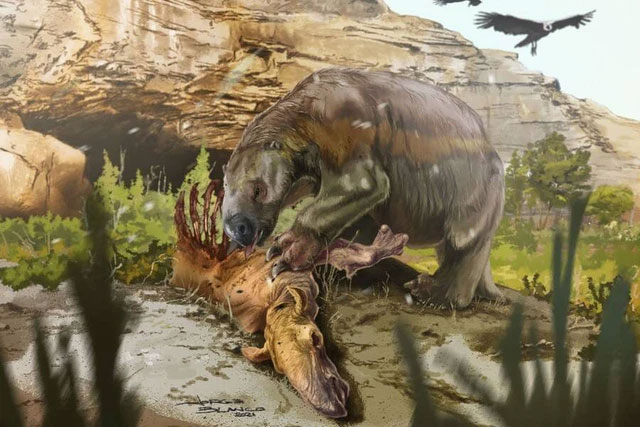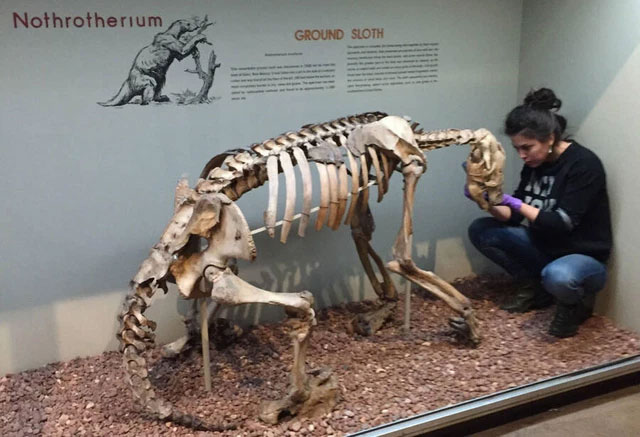Sloths today are small and move slowly. They are herbivorous animals, primarily feeding on leaves and fruits, although some species have been known to eat bird eggs occasionally when they can access them. However, their ancient ancestors were true giants – the ground sloths, and a recent study has shown that they were omnivorous and actively consumed meat.
The lead author of the study, Julia Tejada, a research associate at the American Museum of Natural History and a postdoctoral researcher at the University of Montpellier, stated: “Whether they were scavengers or predators that stole prey from other animals is something that requires further detailed study before we can be certain.”
“But now we have clear evidence against the long-held hypothesis that the giant ground sloth was a strictly herbivorous animal.”

Long thought to be herbivores, new evidence shows that giant sloths were also scavengers. Mylodon is an extinct genus of ground sloth belonging to the family Mylodontidae, known from the Patagonia region in Chile and Argentina in southern South America. With a total length of 3 to 4 meters, it is one of the most famous and largest representatives of the group. The oldest findings may date back to the Pleistocene epoch.
To determine what ancient ground sloths ate, researchers analyzed the nitrogen isotope levels found in their fur. They looked for an isotope called nitrogen-15, which indicates the position of the animal in the food chain – the more of this isotope present, the more meat they consumed.
While researchers found that some giant ground sloths, such as Nothrotheriops shastensis in North America, were indeed herbivores, they also discovered that other species of giant ground sloths were omnivorous. One species found in Patagonia, Mylodon darwinii (M. darwinii), also known as Darwin’s ground sloth, had enough nitrogen-15 isotope in its fur to indicate it consumed both plant and animal matter.
This giant ground sloth was discovered by Charles Darwin in 1832 and was later named after him – they weighed between 2,200 and 4,400 pounds (1 to 2 tons) and could grow up to 13 feet (4 meters) in length. It lived in South America from 1.8 million to 10,000 years ago during the Pleistocene epoch.
“The results of the study clearly indicate that Mylodon was not a strictly herbivorous animal, but rather an omnivore,” Tejada and her co-authors explained in a study published in Scientific Reports.

Mylodon and its relatives were the dominant group of ground sloths in South America. They are distinguished from other ground sloths by the presence of upper canines, triangular-shaped molars, and a small first toe on the hind limb. Two closely related genera, Paramylodon and Glossotherium, were widely distributed and even spread into many regions of North America.
The research team suspects that M. darwinii resembled more of a scavenger than a predator. The absence of bones in the sloth’s feces suggests that it scavenged the remains of other animals or could have obtained animal protein by eating eggs.
While these new findings are surprising, they also answer some longstanding questions about how these ancient giant ground sloths survived.
For instance, M. darwinii had small teeth – the teeth and stomach appear too small for a thriving herbivore. This would likely pose significant issues for strictly herbivorous species; however, it is advantageous for omnivorous animals, allowing them to easily digest high-energy foods like meat.
Moreover, scientists have long suspected that there simply wasn’t enough vegetation for all the herbivores living in South America at the same time as the giant ground sloth.
Thus, the sloth could eat both meat and plants. Indeed, its diverse diet helped this animal survive despite scarce resources. Researchers also suggest that it may have started adapting to eating meat to survive in resource-depleted conditions.
“These results provide the first direct evidence of omnivory in ancient sloths, and thus necessitate a reevaluation of the entire ecological structure of ancient mammal communities in South America,” Tejada said, “as giant ground sloths represented a major component of these ecosystems for millions of years.”
Researchers hope to learn more about their foraging habits and clarify how these giant sloths once lived. Certainly, there is much more to discover about these mysterious giants.


















































